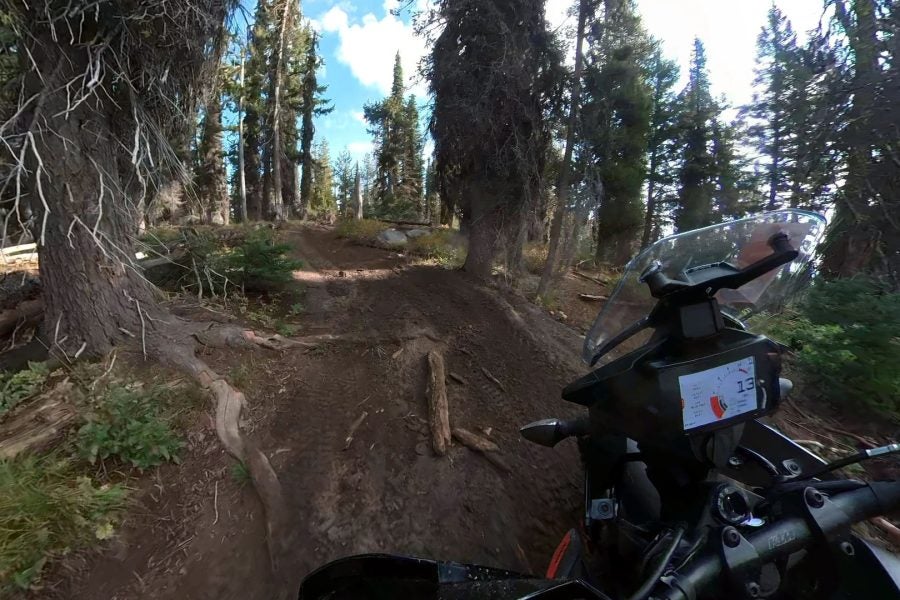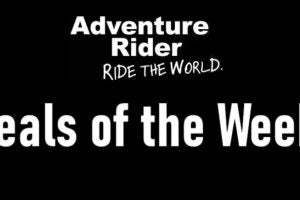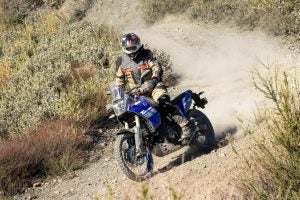The steep, rocky, rutted path to the right heading down the mountainside outside Donnelly, Idaho, looked a bit less rocky and rutted than the two-track to the left, and I pointed the KTM 390 Adventure’s nose to the right and focused forward on the steep trail winding into the woods ahead.
Unfortunately, I focused just a bit too far forward.
A large, long and weathered tree trunk partially obscured by brush and dirt lay across the path at an angle, and I was upon it in a second. I was going too fast and it was too big and oddly angled to mount a bump-and-pop maneuver to clear (at least for me) so I mashed the rear brake and locked it tight in a futile attempt to scrub off speed. The tree trunk was angled such that there was no escape back to the left path, just more tree trunk. Standing trees and a ravine lay to the right. In desperation I grabbed the front brake, but even the ABS, set at the lowest level of intervention, could not save me and the front tire hit the tree trunk at an angle, whip-sawing the bars. The impact stopped all forward progress, throwing me off the bike.
I somersaulted off the 390 and landed in the dirt and grass beyond the tree, my REV’IT! riding gear and Bell helmet absorbing the impact. The 390 lay on its side, sputtering pitifully as I lay prone for a moment, checking my extremities for movement. Braden, a KTM Rally sweep rider, pulled up moments later, and hopped off his bike to assist. Unhurt except for an already-sore wrist now even more sore, I got the 390 upright and free of the tree trunk crash site with some help from Braden. I remounted, took some deep breaths and restarted the undamaged 390 to continue down the steep jeep trail, rattled but otherwise unhurt.
I would not stay upright for long.

The KTM 390 Adventure. Photo: KTM
In my attempt to catch up to the rest of the journalists I was riding with, I added some speed as the two-track transitioned to a wide gravel road, and for a while I made good time, but my new confidence was misplaced. Rounding an off-camber right hand corner with another bike from my group of journalists finally in view, my vision was suddenly reduced by his dust, and I realized too late that the sweeping turn was tightening up quickly. In an instant, I was again sliding the rear wheel of the 390 to try and scrub speed and turn the bike through the bend, to no avail. The front tire washed out as I tried to force the turn while braking, and the 390 and I lowsided onto the gravel and slid off the road—and then down a steep embankment littered with small rocks, dirt and downed tree branches.
My helmet filled with dirt and as I slid, the 390 banged hard into my right ankle, thankfully protected by a TCX Infinity 3 boot. I came to a stop at last, the 390 on its side atop my leg, still in gear and still somehow running, the rear wheel spinning in the air. Pain wracked my right side, but after a few seconds I regained my senses enough to know I was not injured. Well, not seriously.
At that point, I heard Braden ride by, but due to all the dust, he had been far enough back that he did not see me crash and I was far enough down the embankment that he could not see me from the road. I untangled my leg from under the sputtering 390 and hit the kill switch. After clearing the dirt from my helmet, I righted the 390 once again, checked for damage (nothing serious thanks to crash bars), restarted and tried to divine a path back up to the roadway through the debris field. Exhausted from the effort and crash, I wasn’t getting very far. Minutes later, another KTM staffer went by in a pickup truck and spotted me trying to bushwhack my way through the tree limbs and boulders. I relinquished control of the bike to him and he eventually coaxed the 390 back onto the road. In pain and shame, I limped the 390 down the hill back to the group, who were waiting and wondering where I was, especially since Braden had arrived before I did.
Now thoroughly rattled, I broke off from the group and rode to the lunch stop where a KTM moto-riding doctor said he suspected I had torn a ligament in my wrist at some point in all the crashing. He advised me not to ride any more that day and wrapped my wrist. I was done, and the group continued on without me. It was a bruising day for my body—and my ego.
Just weeks prior to the KTM rally, I had piloted a fully-laden Yamaha Ténéré 700 more than 1,200 crash-free miles in a glorious week of solo riding in the Rocky Mountains, much of it off-road and through challenging terrain (story soon). Going into the KTM Adventure Rally, back this year for the 17th running after a two-year COVID hiatus, my confidence was high. And indeed, on the first day of riding at the Rally, I piloted the bone stock 390 Adventure – a bike I’ve never ridden before – through 150-odd miles of Idaho wilderness with no issues, almost all of the miles in the dirt, and often on steep, twisting single track. I wasn’t nearly as fast as the other more experienced press riders, but I had stayed upright, and despite the unfamiliar bike with the just slightly too-low handlebar, I had enjoyed the ride. But Day Two? The routes were more challenging, and my meager skills were not able to keep me up with the rest of the squadron of press riders. No one likes to be the slowest guy out there, but despite being That Guy Who Crashes A Lot, I drew lessons from my dusty defeat in the Idaho mountains.
Lesson One: My road riding skills were a detriment in the dirt

Much of the riding at the KTM Rally was on tight, technical forest tracts we all love to ride on – because they are a challenge. Photo: Bill Roberson
The KTM Rally routes were challenging to be sure, but other riders (most of them, at least) handled them without faceplants into the terra firma, and the press members I was riding with were all on stock 390s just like I was. But decades of street riding habits are hard to break, and many of the things I do automatically on the street are really bad ideas out in the dirt. Front-brake bias, countersteering and sitting in the seat too much while dirt riding were all the wrong way to stay upright. I could make excuses and complain about the 390’s bars being too low, etc., but in truth it was a surprisingly capable bike, with proper tires, a rev-happy engine that powered me up silly-steep grades and enough suspension to absorb all but the hardest hits with control and well-damped action. As hard as it was to admit, the shortcoming lay in my riding skills, not the machinery.
On the third and final day of the rally, while other press riders soaked up a final spin on the steep slopes surrounding the base camp, I spent two hours with renowned off-road ride instructor and ex-racer Jimmy Lewis, getting instruction to help temporarily shelve my road riding habits and learn some new ones for safety in the dirt. Key takeaways: I was trying to go too fast for my skills on low-traction surfaces, and was making several mistakes around bike control and balance that were reliably sending me to the ground. “Ride your pace, don’t worry about the rest of them,” Lewis said. Which plays right into:
Lesson Two: Check your ego, reduce your speed, and you’ll go faster

Right turns were my nemesis. Here I’m cutting way too close to a tree in the corner. Photo: Bill Roberson
Both times I went down, I was trying to catch up to riders far faster than myself. No one wants to be the long-lost rider limping into the lunch stop. I readily admit I hate being The Last Rider to… anywhere. I’m competitive, just like many riders. Track schools, track days and decades of aggressive sportbike riding mean I can keep pace with most anyone on the street. On the dirt? Not even close. I was the noob, the rookie, the Slow Guy.
But after that second crash, I essentially said to myself “Fuck it, I’m going to arrive alive, pride be damned.” Funny thing was, when I decided to “slow down,” I felt I was actually going a bit… faster. I had more control, so I slowed down… less. I ran with the banking in the corners instead of going over it, and rolling the throttle on out of the corners gave me a bit of rear wheel slip on acceleration, which became fun to control. It’s when the front wheel starts to slide I get panicky – that’s my street riding talking. So I kept the speed down in corners and tried to find better techniques.
Back at base camp, Lewis confirmed my observations about speed and control. “Go slow to go fast,” he said with a laugh. “Oh, it’s absolutely true.” He also gave me some solid basic techniques to implement and build on while riding on low-traction surfaces like dirt, mud, sand, silt and loose rocks. Most (if not all) of the riders I was with had lengthy dirt riding experience, whether on ADV bikes or going back to dirt bikes as a kids, or even racing experience. Outside of my DR650 experience (and more recently, the Harley Pan America, KLR650 and Yamaha T7), I’m entirely (and recently) self-taught through riding off-pavement using larger, heavier bikes.
Lewis explained and demonstrated tips around balance, throttle control, braking and more that I’ll be putting into practice going forward. As he says, there really is no “ADV riding technique,” it’s really just about using basic dirt bike riding skills while off the pavement. And you don’t need to unlearn your street skills, you just have to add dirt riding skills to your repertoire and implement them when the asphalt ends. Lewis says it really all comes down to balance, brakes, and speed control on low traction surfaces. Check your ego and utilize the first two, and you’ll get more of the speed thing. Push too hard and down you’ll go. And down I went indeed.
Lesson Three: Good gear makes a huge difference in a crash

All geared up and ready to crash. By the end of the day, my spiffy REV’IT! ensemble would need some deep cleaning and repair. Photo: KTM
I don’t crash motorcycles very often (at least until now), and I used to chuckle at a talented riding pal who always had the latest and most expensive off-road gear, from helmets to braces to a med kit in his jacket back. With his skills, why all the fancy gear? I wonder no more.
Not long ago I started using a properly fitted and padded off-road REV’IT! Offtrack ensemble after years of essentially wearing street gear and some strap-on knee pads while on my DR650. But when I recently got more serious about ADV riding, I noticed every other ADV rider I saw seemed armored up to the max with gear. Now, I better understand why. On this outing I was wearing TCX Infinity 3 boots, padded REV’IT! jacket and pants, and a Bell MX-9 Adventure helmet I have in for review. My hands were in Adventure Spec Dirt gloves, and when push came to crash, all of it did its job and protected my fragile meaty parts. If I had been in jeans, hiking boots, a denim jacket and an old helmet, it’s very doubtful I would have been able to remount after either dismount. Invest in proper gear that fits right and protects you. It may look like ADV riders are often rolling brand name collages, but if those products truly protect you, maybe the free advertising you’re producing is worth it. Side benefit: Good ADV gear is quite comfortable and reduces fatigue on a long ride compared to most street gear. That’s been my experience at least. Also: Lots more pockets.
Finally, I’m committed to practicing the tips Lewis and others gave me post-crashes. I hope to be back at the KTM Adventure Rally in 2023 with a new suite of practiced dirt riding skills, and if I’m still the Slow Guy or the Last Guy, well, so be it. It beats crashing.

On balance, the KTM Rally was great fun, with amazing routes, happy riders, good weather and lessons to be learned. Photo: Bill Roberson







